ECU FORD SIERRA 1989 2.G DOHC Engine Workshop Manual
[x] Cancel search | Manufacturer: FORD, Model Year: 1989, Model line: SIERRA, Model: FORD SIERRA 1989 2.GPages: 18, PDF Size: 0.9 MB
Page 4 of 18
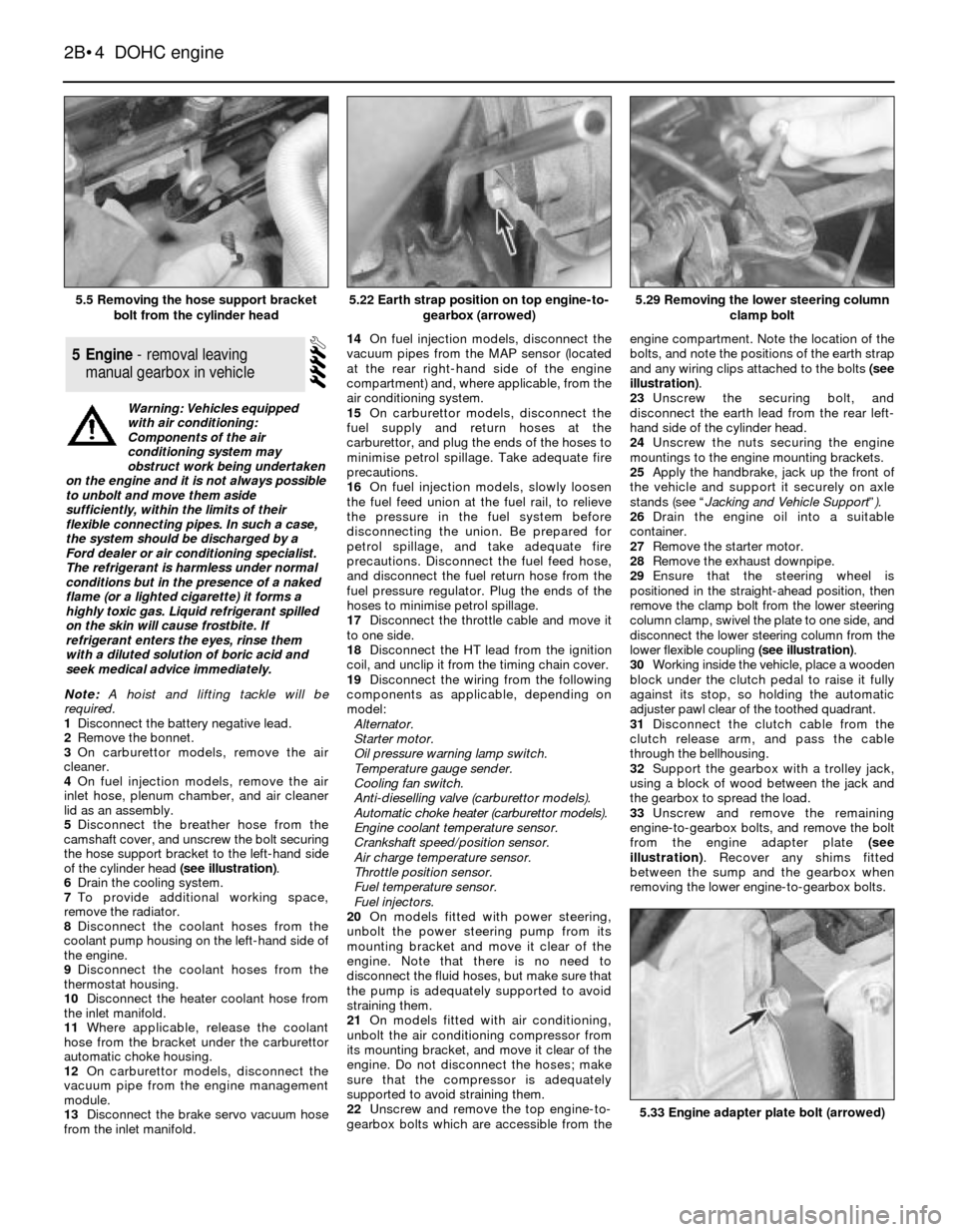
Note:A hoist and lifting tackle will be
required.
1Disconnect the battery negative lead.
2Remove the bonnet.
3On carburettor models, remove the air
cleaner.
4On fuel injection models, remove the air
inlet hose, plenum chamber, and air cleaner
lid as an assembly.
5Disconnect the breather hose from the
camshaft cover, and unscrew the bolt securing
the hose support bracket to the left-hand side
of the cylinder head (see illustration).
6Drain the cooling system.
7To provide additional working space,
remove the radiator.
8Disconnect the coolant hoses from the
coolant pump housing on the left-hand side of
the engine.
9Disconnect the coolant hoses from the
thermostat housing.
10Disconnect the heater coolant hose from
the inlet manifold.
11Where applicable, release the coolant
hose from the bracket under the carburettor
automatic choke housing.
12On carburettor models, disconnect the
vacuum pipe from the engine management
module.
13Disconnect the brake servo vacuum hose
from the inlet manifold.14On fuel injection models, disconnect the
vacuum pipes from the MAP sensor (located
at the rear right-hand side of the engine
compartment) and, where applicable, from the
air conditioning system.
15On carburettor models, disconnect the
fuel supply and return hoses at the
carburettor, and plug the ends of the hoses to
minimise petrol spillage. Take adequate fire
precautions.
16On fuel injection models, slowly loosen
the fuel feed union at the fuel rail, to relieve
the pressure in the fuel system before
disconnecting the union. Be prepared for
petrol spillage, and take adequate fire
precautions. Disconnect the fuel feed hose,
and disconnect the fuel return hose from the
fuel pressure regulator. Plug the ends of the
hoses to minimise petrol spillage.
17Disconnect the throttle cable and move it
to one side.
18Disconnect the HT lead from the ignition
coil, and unclip it from the timing chain cover.
19Disconnect the wiring from the following
components as applicable, depending on
model:
Alternator.
Starter motor.
Oil pressure warning lamp switch.
Temperature gauge sender.
Cooling fan switch.
Anti-dieselling valve (carburettor models).
Automatic choke heater (carburettor models).
Engine coolant temperature sensor.
Crankshaft speed/position sensor.
Air charge temperature sensor.
Throttle position sensor.
Fuel temperature sensor.
Fuel injectors.
20On models fitted with power steering,
unbolt the power steering pump from its
mounting bracket and move it clear of the
engine. Note that there is no need to
disconnect the fluid hoses, but make sure that
the pump is adequately supported to avoid
straining them.
21On models fitted with air conditioning,
unbolt the air conditioning compressor from
its mounting bracket, and move it clear of the
engine. Do not disconnect the hoses; make
sure that the compressor is adequately
supported to avoid straining them.
22Unscrew and remove the top engine-to-
gearbox bolts which are accessible from theengine compartment. Note the location of the
bolts, and note the positions of the earth strap
and any wiring clips attached to the bolts (see
illustration).
23Unscrew the securing bolt, and
disconnect the earth lead from the rear left-
hand side of the cylinder head.
24Unscrew the nuts securing the engine
mountings to the engine mounting brackets.
25Apply the handbrake, jack up the front of
the vehicle and support it securely on axle
stands (see “Jacking and Vehicle Support”).
26Drain the engine oil into a suitable
container.
27Remove the starter motor.
28Remove the exhaust downpipe.
29Ensure that the steering wheel is
positioned in the straight-ahead position, then
remove the clamp bolt from the lower steering
column clamp, swivel the plate to one side, and
disconnect the lower steering column from the
lower flexible coupling (see illustration).
30Working inside the vehicle, place a wooden
block under the clutch pedal to raise it fully
against its stop, so holding the automatic
adjuster pawl clear of the toothed quadrant.
31Disconnect the clutch cable from the
clutch release arm, and pass the cable
through the bellhousing.
32Support the gearbox with a trolley jack,
using a block of wood between the jack and
the gearbox to spread the load.
33Unscrew and remove the remaining
engine-to-gearbox bolts, and remove the bolt
from the engine adapter plate (see
illustration). Recover any shims fitted
between the sump and the gearbox when
removing the lower engine-to-gearbox bolts.
5Engine - removal leaving
manual gearbox in vehicle
2B•4DOHC engine
5.5 Removing the hose support bracket
bolt from the cylinder head5.29 Removing the lower steering column
clamp bolt
5.33 Engine adapter plate bolt (arrowed)
5.22 Earth strap position on top engine-to-
gearbox (arrowed)
Warning: Vehicles equipped
with air conditioning:
Components of the air
conditioning system may
obstruct work being undertaken
on the engine and it is not always possible
to unbolt and move them aside
sufficiently, within the limits of their
flexible connecting pipes. In such a case,
the system should be discharged by a
Ford dealer or air conditioning specialist.
The refrigerant is harmless under normal
conditions but in the presence of a naked
flame (or a lighted cigarette) it forms a
highly toxic gas. Liquid refrigerant spilled
on the skin will cause frostbite. If
refrigerant enters the eyes, rinse them
with a diluted solution of boric acid and
seek medical advice immediately.
Page 5 of 18
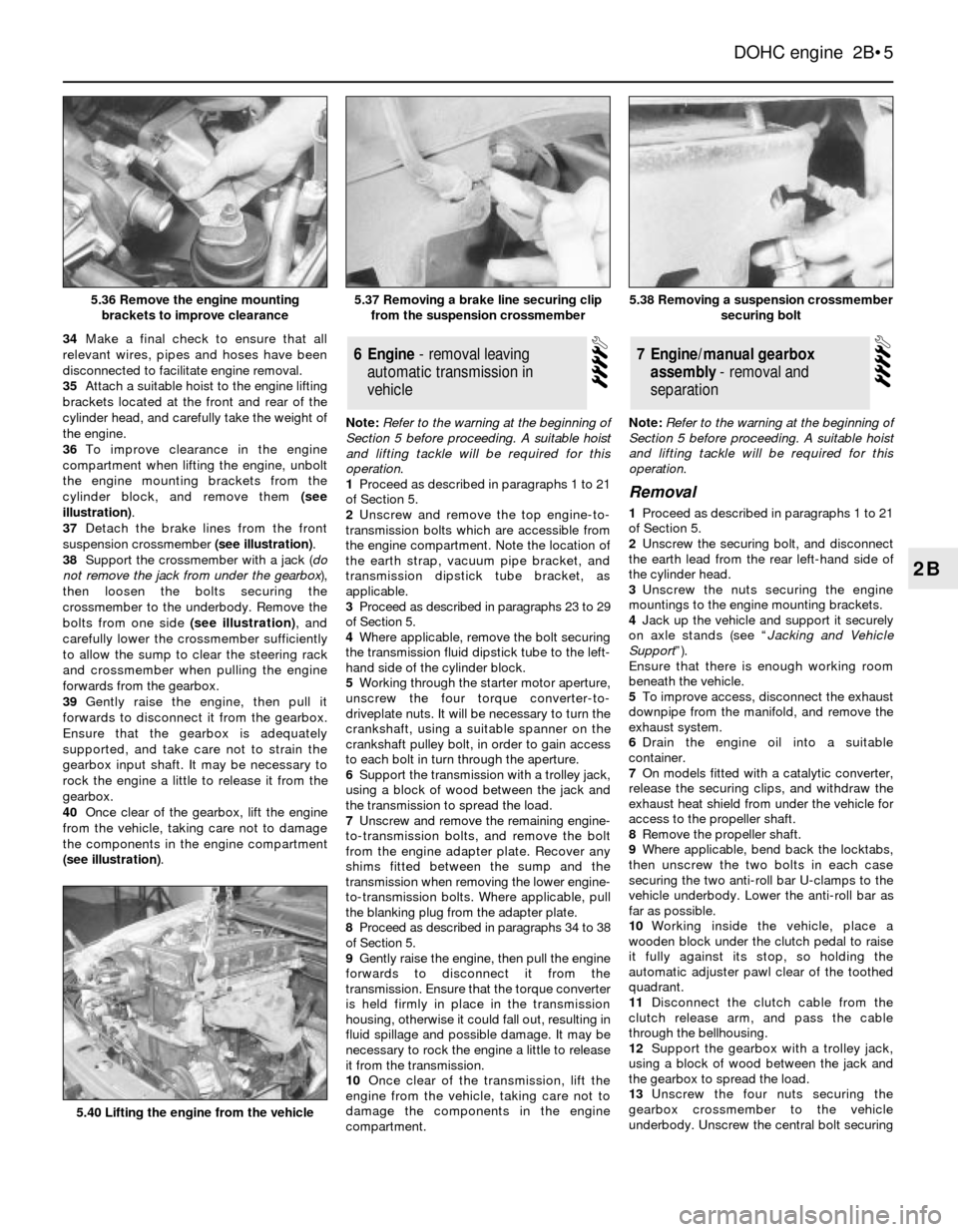
34Make a final check to ensure that all
relevant wires, pipes and hoses have been
disconnected to facilitate engine removal.
35Attach a suitable hoist to the engine lifting
brackets located at the front and rear of the
cylinder head, and carefully take the weight of
the engine.
36To improve clearance in the engine
compartment when lifting the engine, unbolt
the engine mounting brackets from the
cylinder block, and remove them (see
illustration).
37Detach the brake lines from the front
suspension crossmember (see illustration).
38Support the crossmember with a jack (do
not remove the jack from under the gearbox),
then loosen the bolts securing the
crossmember to the underbody. Remove the
bolts from one side (see illustration), and
carefully lower the crossmember sufficiently
to allow the sump to clear the steering rack
and crossmember when pulling the engine
forwards from the gearbox.
39Gently raise the engine, then pull it
forwards to disconnect it from the gearbox.
Ensure that the gearbox is adequately
supported, and take care not to strain the
gearbox input shaft. It may be necessary to
rock the engine a little to release it from the
gearbox.
40Once clear of the gearbox, lift the engine
from the vehicle, taking care not to damage
the components in the engine compartment
(see illustration).Note: Refer to the warning at the beginning of
Section 5 before proceeding. A suitable hoist
and lifting tackle will be required for this
operation.
1Proceed as described in paragraphs 1 to 21
of Section 5.
2Unscrew and remove the top engine-to-
transmission bolts which are accessible from
the engine compartment. Note the location of
the earth strap, vacuum pipe bracket, and
transmission dipstick tube bracket, as
applicable.
3Proceed as described in paragraphs 23 to 29
of Section 5.
4Where applicable, remove the bolt securing
the transmission fluid dipstick tube to the left-
hand side of the cylinder block.
5Working through the starter motor aperture,
unscrew the four torque converter-to-
driveplate nuts. It will be necessary to turn the
crankshaft, using a suitable spanner on the
crankshaft pulley bolt, in order to gain access
to each bolt in turn through the aperture.
6Support the transmission with a trolley jack,
using a block of wood between the jack and
the transmission to spread the load.
7Unscrew and remove the remaining engine-
to-transmission bolts, and remove the bolt
from the engine adapter plate. Recover any
shims fitted between the sump and the
transmission when removing the lower engine-
to-transmission bolts. Where applicable, pull
the blanking plug from the adapter plate.
8Proceed as described in paragraphs 34 to 38
of Section 5.
9Gently raise the engine, then pull the engine
forwards to disconnect it from the
transmission. Ensure that the torque converter
is held firmly in place in the transmission
housing, otherwise it could fall out, resulting in
fluid spillage and possible damage. It may be
necessary to rock the engine a little to release
it from the transmission.
10Once clear of the transmission, lift the
engine from the vehicle, taking care not to
damage the components in the engine
compartment.Note: Refer to the warning at the beginning of
Section 5 before proceeding. A suitable hoist
and lifting tackle will be required for this
operation.
Removal
1Proceed as described in paragraphs 1 to 21
of Section 5.
2Unscrew the securing bolt, and disconnect
the earth lead from the rear left-hand side of
the cylinder head.
3Unscrew the nuts securing the engine
mountings to the engine mounting brackets.
4Jack up the vehicle and support it securely
on axle stands (see “Jacking and Vehicle
Support”).
Ensure that there is enough working room
beneath the vehicle.
5To improve access, disconnect the exhaust
downpipe from the manifold, and remove the
exhaust system.
6Drain the engine oil into a suitable
container.
7On models fitted with a catalytic converter,
release the securing clips, and withdraw the
exhaust heat shield from under the vehicle for
access to the propeller shaft.
8Remove the propeller shaft.
9Where applicable, bend back the locktabs,
then unscrew the two bolts in each case
securing the two anti-roll bar U-clamps to the
vehicle underbody. Lower the anti-roll bar as
far as possible.
10Working inside the vehicle, place a
wooden block under the clutch pedal to raise
it fully against its stop, so holding the
automatic adjuster pawl clear of the toothed
quadrant.
11Disconnect the clutch cable from the
clutch release arm, and pass the cable
through the bellhousing.
12Support the gearbox with a trolley jack,
using a block of wood between the jack and
the gearbox to spread the load.
13Unscrew the four nuts securing the
gearbox crossmember to the vehicle
underbody. Unscrew the central bolt securing
7Engine/manual gearbox
assembly - removal and
separation6Engine - removal leaving
automatic transmission in
vehicle
DOHC engine 2B•5
2B
5.38 Removing a suspension crossmember
securing bolt
5.40 Lifting the engine from the vehicle
5.37 Removing a brake line securing clip
from the suspension crossmember5.36 Remove the engine mounting
brackets to improve clearance
Page 6 of 18
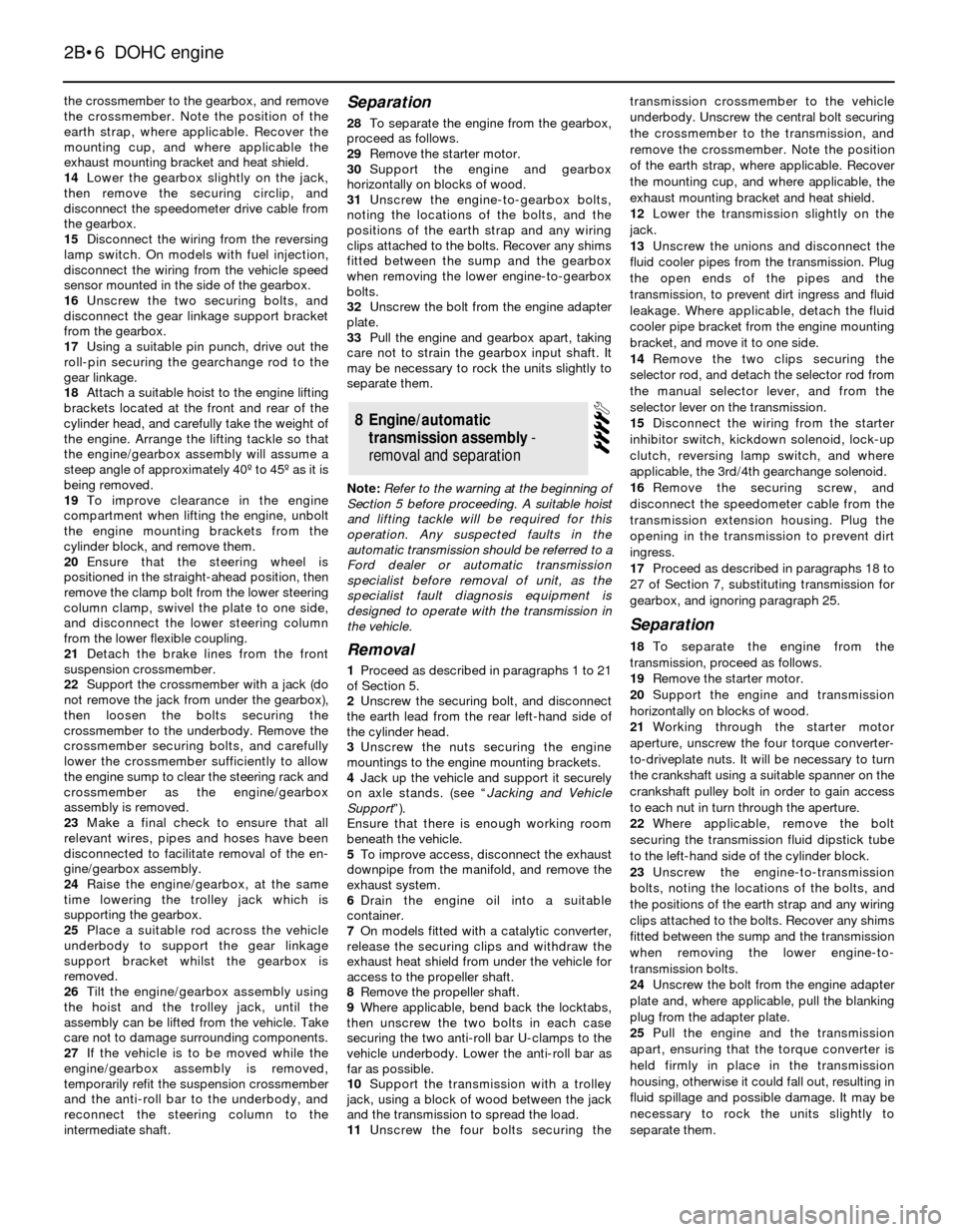
the crossmember to the gearbox, and remove
the crossmember. Note the position of the
earth strap, where applicable. Recover the
mounting cup, and where applicable the
exhaust mounting bracket and heat shield.
14Lower the gearbox slightly on the jack,
then remove the securing circlip, and
disconnect the speedometer drive cable from
the gearbox.
15Disconnect the wiring from the reversing
lamp switch. On models with fuel injection,
disconnect the wiring from the vehicle speed
sensor mounted in the side of the gearbox.
16Unscrew the two securing bolts, and
disconnect the gear linkage support bracket
from the gearbox.
17Using a suitable pin punch, drive out the
roll-pin securing the gearchange rod to the
gear linkage.
18Attach a suitable hoist to the engine lifting
brackets located at the front and rear of the
cylinder head, and carefully take the weight of
the engine. Arrange the lifting tackle so that
the engine/gearbox assembly will assume a
steep angle of approximately 40º to 45º as it is
being removed.
19To improve clearance in the engine
compartment when lifting the engine, unbolt
the engine mounting brackets from the
cylinder block, and remove them.
20Ensure that the steering wheel is
positioned in the straight-ahead position, then
remove the clamp bolt from the lower steering
column clamp, swivel the plate to one side,
and disconnect the lower steering column
from the lower flexible coupling.
21Detach the brake lines from the front
suspension crossmember.
22Support the crossmember with a jack (do
not remove the jack from under the gearbox),
then loosen the bolts securing the
crossmember to the underbody. Remove the
crossmember securing bolts, and carefully
lower the crossmember sufficiently to allow
the engine sump to clear the steering rack and
crossmember as the engine/gearbox
assembly is removed.
23Make a final check to ensure that all
relevant wires, pipes and hoses have been
disconnected to facilitate removal of the en-
gine/gearbox assembly.
24Raise the engine/gearbox, at the same
time lowering the trolley jack which is
supporting the gearbox.
25Place a suitable rod across the vehicle
underbody to support the gear linkage
support bracket whilst the gearbox is
removed.
26Tilt the engine/gearbox assembly using
the hoist and the trolley jack, until the
assembly can be lifted from the vehicle. Take
care not to damage surrounding components.
27If the vehicle is to be moved while the
engine/gearbox assembly is removed,
temporarily refit the suspension crossmember
and the anti-roll bar to the underbody, and
reconnect the steering column to the
intermediate shaft.Separation
28To separate the engine from the gearbox,
proceed as follows.
29Remove the starter motor.
30Support the engine and gearbox
horizontally on blocks of wood.
31Unscrew the engine-to-gearbox bolts,
noting the locations of the bolts, and the
positions of the earth strap and any wiring
clips attached to the bolts. Recover any shims
fitted between the sump and the gearbox
when removing the lower engine-to-gearbox
bolts.
32Unscrew the bolt from the engine adapter
plate.
33Pull the engine and gearbox apart, taking
care not to strain the gearbox input shaft. It
may be necessary to rock the units slightly to
separate them.
Note: Refer to the warning at the beginning of
Section 5 before proceeding. A suitable hoist
and lifting tackle will be required for this
operation. Any suspected faults in the
automatic transmission should be referred to a
Ford dealer or automatic transmission
specialist before removal of unit, as the
specialist fault diagnosis equipment is
designed to operate with the transmission in
the vehicle.
Removal
1Proceed as described in paragraphs 1 to 21
of Section 5.
2Unscrew the securing bolt, and disconnect
the earth lead from the rear left-hand side of
the cylinder head.
3Unscrew the nuts securing the engine
mountings to the engine mounting brackets.
4Jack up the vehicle and support it securely
on axle stands. (see “Jacking and Vehicle
Support”).
Ensure that there is enough working room
beneath the vehicle.
5To improve access, disconnect the exhaust
downpipe from the manifold, and remove the
exhaust system.
6Drain the engine oil into a suitable
container.
7On models fitted with a catalytic converter,
release the securing clips and withdraw the
exhaust heat shield from under the vehicle for
access to the propeller shaft.
8Remove the propeller shaft.
9Where applicable, bend back the locktabs,
then unscrew the two bolts in each case
securing the two anti-roll bar U-clamps to the
vehicle underbody. Lower the anti-roll bar as
far as possible.
10Support the transmission with a trolley
jack, using a block of wood between the jack
and the transmission to spread the load.
11Unscrew the four bolts securing thetransmission crossmember to the vehicle
underbody. Unscrew the central bolt securing
the crossmember to the transmission, and
remove the crossmember. Note the position
of the earth strap, where applicable. Recover
the mounting cup, and where applicable, the
exhaust mounting bracket and heat shield.
12Lower the transmission slightly on the
jack.
13Unscrew the unions and disconnect the
fluid cooler pipes from the transmission. Plug
the open ends of the pipes and the
transmission, to prevent dirt ingress and fluid
leakage. Where applicable, detach the fluid
cooler pipe bracket from the engine mounting
bracket, and move it to one side.
14Remove the two clips securing the
selector rod, and detach the selector rod from
the manual selector lever, and from the
selector lever on the transmission.
15Disconnect the wiring from the starter
inhibitor switch, kickdown solenoid, lock-up
clutch, reversing lamp switch, and where
applicable, the 3rd/4th gearchange solenoid.
16Remove the securing screw, and
disconnect the speedometer cable from the
transmission extension housing. Plug the
opening in the transmission to prevent dirt
ingress.
17Proceed as described in paragraphs 18 to
27 of Section 7, substituting transmission for
gearbox, and ignoring paragraph 25.
Separation
18To separate the engine from the
transmission, proceed as follows.
19Remove the starter motor.
20Support the engine and transmission
horizontally on blocks of wood.
21Working through the starter motor
aperture, unscrew the four torque converter-
to-driveplate nuts. It will be necessary to turn
the crankshaft using a suitable spanner on the
crankshaft pulley bolt in order to gain access
to each nut in turn through the aperture.
22Where applicable, remove the bolt
securing the transmission fluid dipstick tube
to the left-hand side of the cylinder block.
23Unscrew the engine-to-transmission
bolts, noting the locations of the bolts, and
the positions of the earth strap and any wiring
clips attached to the bolts. Recover any shims
fitted between the sump and the transmission
when removing the lower engine-to-
transmission bolts.
24Unscrew the bolt from the engine adapter
plate and, where applicable, pull the blanking
plug from the adapter plate.
25Pull the engine and the transmission
apart, ensuring that the torque converter is
held firmly in place in the transmission
housing, otherwise it could fall out, resulting in
fluid spillage and possible damage. It may be
necessary to rock the units slightly to
separate them.
8Engine/automatic
transmission assembly -
removal and separation
2B•6DOHC engine
Page 7 of 18
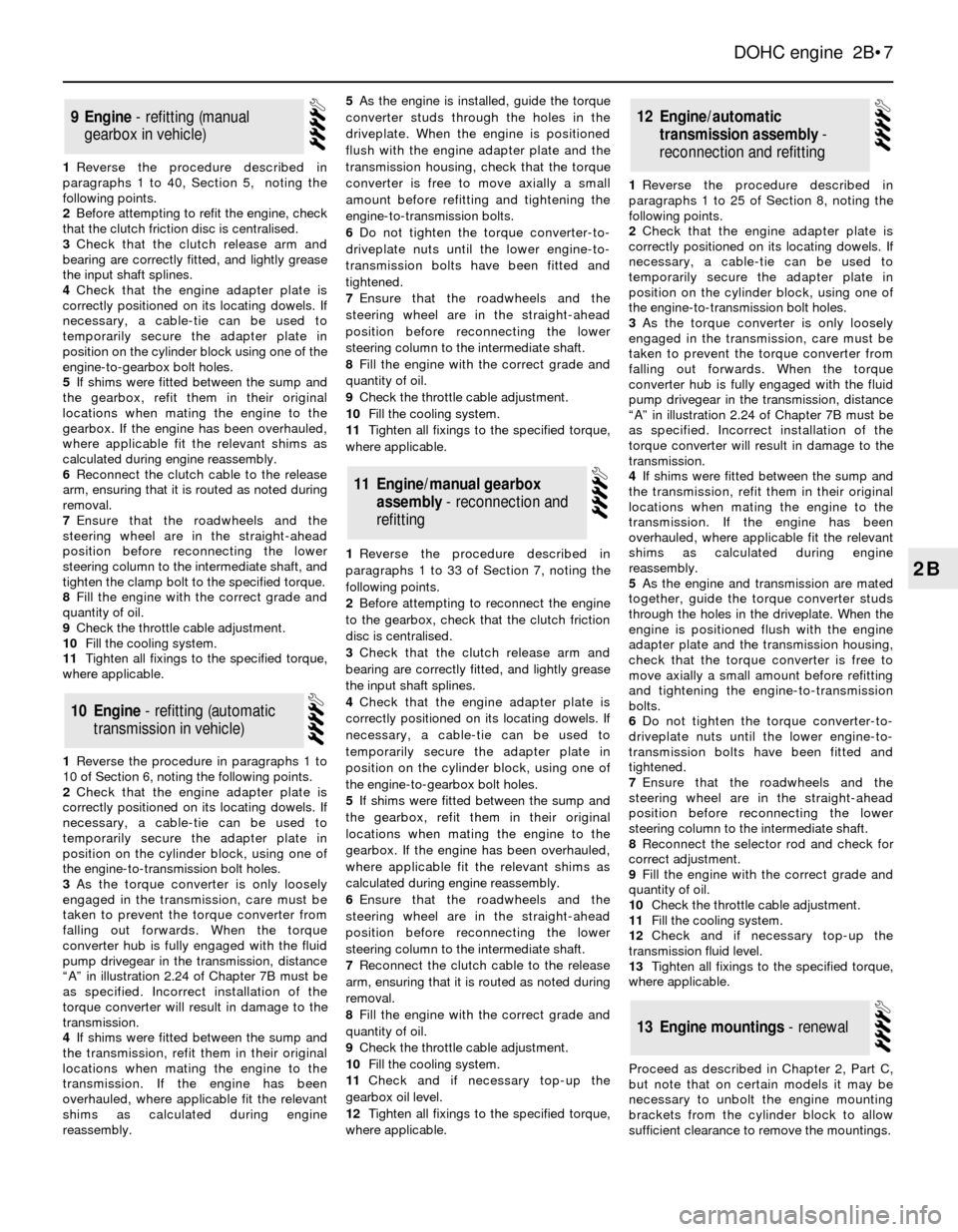
1Reverse the procedure described in
paragraphs 1 to 40, Section 5, noting the
following points.
2Before attempting to refit the engine, check
that the clutch friction disc is centralised.
3Check that the clutch release arm and
bearing are correctly fitted, and lightly grease
the input shaft splines.
4Check that the engine adapter plate is
correctly positioned on its locating dowels. If
necessary, a cable-tie can be used to
temporarily secure the adapter plate in
position on the cylinder block using one of the
engine-to-gearbox bolt holes.
5If shims were fitted between the sump and
the gearbox, refit them in their original
locations when mating the engine to the
gearbox. If the engine has been overhauled,
where applicable fit the relevant shims as
calculated during engine reassembly.
6Reconnect the clutch cable to the release
arm, ensuring that it is routed as noted during
removal.
7Ensure that the roadwheels and the
steering wheel are in the straight-ahead
position before reconnecting the lower
steering column to the intermediate shaft, and
tighten the clamp bolt to the specified torque.
8Fill the engine with the correct grade and
quantity of oil.
9Check the throttle cable adjustment.
10Fill the cooling system.
11Tighten all fixings to the specified torque,
where applicable.
1Reverse the procedure in paragraphs 1 to
10 of Section 6, noting the following points.
2Check that the engine adapter plate is
correctly positioned on its locating dowels. If
necessary, a cable-tie can be used to
temporarily secure the adapter plate in
position on the cylinder block, using one of
the engine-to-transmission bolt holes.
3As the torque converter is only loosely
engaged in the transmission, care must be
taken to prevent the torque converter from
falling out forwards. When the torque
converter hub is fully engaged with the fluid
pump drivegear in the transmission, distance
“A” in illustration 2.24 of Chapter 7B must be
as specified. Incorrect installation of the
torque converter will result in damage to the
transmission.
4If shims were fitted between the sump and
the transmission, refit them in their original
locations when mating the engine to the
transmission. If the engine has been
overhauled, where applicable fit the relevant
shims as calculated during engine
reassembly.5As the engine is installed, guide the torque
converter studs through the holes in the
driveplate. When the engine is positioned
flush with the engine adapter plate and the
transmission housing, check that the torque
converter is free to move axially a small
amount before refitting and tightening the
engine-to-transmission bolts.
6Do not tighten the torque converter-to-
driveplate nuts until the lower engine-to-
transmission bolts have been fitted and
tightened.
7Ensure that the roadwheels and the
steering wheel are in the straight-ahead
position before reconnecting the lower
steering column to the intermediate shaft.
8Fill the engine with the correct grade and
quantity of oil.
9Check the throttle cable adjustment.
10Fill the cooling system.
11Tighten all fixings to the specified torque,
where applicable.
1Reverse the procedure described in
paragraphs 1 to 33 of Section 7, noting the
following points.
2Before attempting to reconnect the engine
to the gearbox, check that the clutch friction
disc is centralised.
3Check that the clutch release arm and
bearing are correctly fitted, and lightly grease
the input shaft splines.
4Check that the engine adapter plate is
correctly positioned on its locating dowels. If
necessary, a cable-tie can be used to
temporarily secure the adapter plate in
position on the cylinder block, using one of
the engine-to-gearbox bolt holes.
5If shims were fitted between the sump and
the gearbox, refit them in their original
locations when mating the engine to the
gearbox. If the engine has been overhauled,
where applicable fit the relevant shims as
calculated during engine reassembly.
6Ensure that the roadwheels and the
steering wheel are in the straight-ahead
position before reconnecting the lower
steering column to the intermediate shaft.
7Reconnect the clutch cable to the release
arm, ensuring that it is routed as noted during
removal.
8Fill the engine with the correct grade and
quantity of oil.
9Check the throttle cable adjustment.
10Fill the cooling system.
11Check and if necessary top-up the
gearbox oil level.
12Tighten all fixings to the specified torque,
where applicable.1Reverse the procedure described in
paragraphs 1 to 25 of Section 8, noting the
following points.
2Check that the engine adapter plate is
correctly positioned on its locating dowels. If
necessary, a cable-tie can be used to
temporarily secure the adapter plate in
position on the cylinder block, using one of
the engine-to-transmission bolt holes.
3As the torque converter is only loosely
engaged in the transmission, care must be
taken to prevent the torque converter from
falling out forwards. When the torque
converter hub is fully engaged with the fluid
pump drivegear in the transmission, distance
“A” in illustration 2.24 of Chapter 7B must be
as specified. Incorrect installation of the
torque converter will result in damage to the
transmission.
4If shims were fitted between the sump and
the transmission, refit them in their original
locations when mating the engine to the
transmission. If the engine has been
overhauled, where applicable fit the relevant
shims as calculated during engine
reassembly.
5As the engine and transmission are mated
together, guide the torque converter studs
through the holes in the driveplate. When the
engine is positioned flush with the engine
adapter plate and the transmission housing,
check that the torque converter is free to
move axially a small amount before refitting
and tightening the engine-to-transmission
bolts.
6Do not tighten the torque converter-to-
driveplate nuts until the lower engine-to-
transmission bolts have been fitted and
tightened.
7Ensure that the roadwheels and the
steering wheel are in the straight-ahead
position before reconnecting the lower
steering column to the intermediate shaft.
8Reconnect the selector rod and check for
correct adjustment.
9Fill the engine with the correct grade and
quantity of oil.
10Check the throttle cable adjustment.
11Fill the cooling system.
12Check and if necessary top-up the
transmission fluid level.
13Tighten all fixings to the specified torque,
where applicable.
Proceed as described in Chapter 2, Part C,
but note that on certain models it may be
necessary to unbolt the engine mounting
brackets from the cylinder block to allow
sufficient clearance to remove the mountings.
13Engine mountings - renewal
12Engine/automatic
transmission assembly -
reconnection and refitting
11Engine/manual gearbox
assembly - reconnection and
refitting
10Engine - refitting (automatic
transmission in vehicle)
9Engine - refitting (manual
gearbox in vehicle)
DOHC engine 2B•7
2B
Page 9 of 18
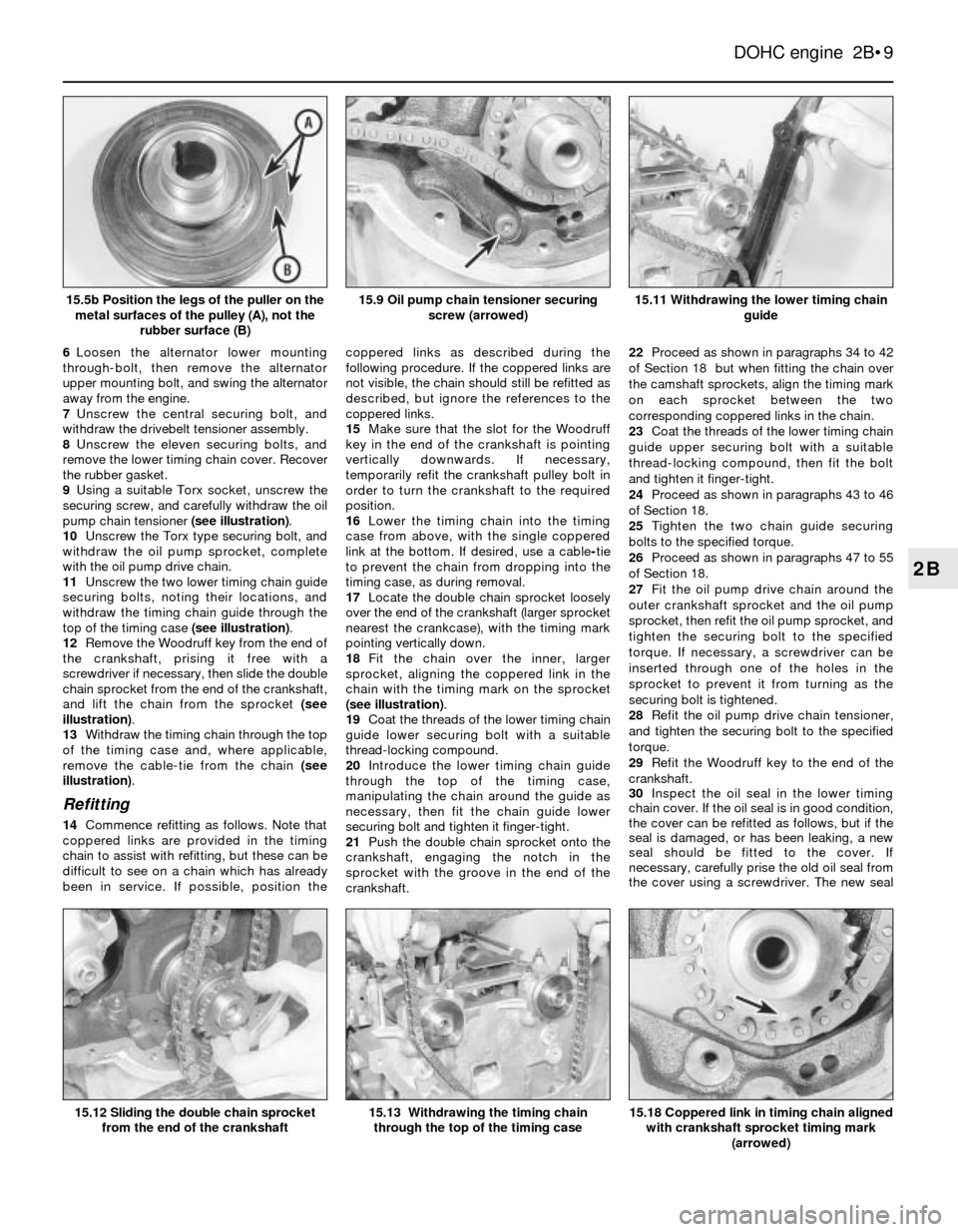
6Loosen the alternator lower mounting
through-bolt, then remove the alternator
upper mounting bolt, and swing the alternator
away from the engine.
7Unscrew the central securing bolt, and
withdraw the drivebelt tensioner assembly.
8Unscrew the eleven securing bolts, and
remove the lower timing chain cover. Recover
the rubber gasket.
9Using a suitable Torx socket, unscrew the
securing screw, and carefully withdraw the oil
pump chain tensioner (see illustration).
10Unscrew the Torx type securing bolt, and
withdraw the oil pump sprocket, complete
with the oil pump drive chain.
11Unscrew the two lower timing chain guide
securing bolts, noting their locations, and
withdraw the timing chain guide through the
top of the timing case (see illustration).
12Remove the Woodruff key from the end of
the crankshaft, prising it free with a
screwdriver if necessary, then slide the double
chain sprocket from the end of the crankshaft,
and lift the chain from the sprocket (see
illustration).
13Withdraw the timing chain through the top
of the timing case and, where applicable,
remove the cable-tie from the chain (see
illustration).
Refitting
14Commence refitting as follows. Note that
coppered links are provided in the timing
chain to assist with refitting, but these can be
difficult to see on a chain which has already
been in service. If possible, position thecoppered links as described during the
following procedure. If the coppered links are
not visible, the chain should still be refitted as
described, but ignore the references to the
coppered links.
15Make sure that the slot for the Woodruff
key in the end of the crankshaft is pointing
vertically downwards. If necessary,
temporarily refit the crankshaft pulley bolt in
order to turn the crankshaft to the required
position.
16Lower the timing chain into the timing
case from above, with the single coppered
link at the bottom. If desired, use a cable-tie
to prevent the chain from dropping into the
timing case, as during removal.
17Locate the double chain sprocket loosely
over the end of the crankshaft (larger sprocket
nearest the crankcase), with the timing mark
pointing vertically down.
18Fit the chain over the inner, larger
sprocket, aligning the coppered link in the
chain with the timing mark on the sprocket
(see illustration).
19Coat the threads of the lower timing chain
guide lower securing bolt with a suitable
thread-locking compound.
20Introduce the lower timing chain guide
through the top of the timing case,
manipulating the chain around the guide as
necessary, then fit the chain guide lower
securing bolt and tighten it finger-tight.
21Push the double chain sprocket onto the
crankshaft, engaging the notch in the
sprocket with the groove in the end of the
crankshaft.22Proceed as shown in paragraphs 34 to 42
of Section 18 but when fitting the chain over
the camshaft sprockets, align the timing mark
on each sprocket between the two
corresponding coppered links in the chain.
23Coat the threads of the lower timing chain
guide upper securing bolt with a suitable
thread-locking compound, then fit the bolt
and tighten it finger-tight.
24Proceed as shown in paragraphs 43 to 46
of Section 18.
25Tighten the two chain guide securing
bolts to the specified torque.
26Proceed as shown in paragraphs 47 to 55
of Section 18.
27Fit the oil pump drive chain around the
outer crankshaft sprocket and the oil pump
sprocket, then refit the oil pump sprocket, and
tighten the securing bolt to the specified
torque. If necessary, a screwdriver can be
inserted through one of the holes in the
sprocket to prevent it from turning as the
securing bolt is tightened.
28Refit the oil pump drive chain tensioner,
and tighten the securing bolt to the specified
torque.
29Refit the Woodruff key to the end of the
crankshaft.
30Inspect the oil seal in the lower timing
chain cover. If the oil seal is in good condition,
the cover can be refitted as follows, but if the
seal is damaged, or has been leaking, a new
seal should be fitted to the cover. If
necessary, carefully prise the old oil seal from
the cover using a screwdriver. The new seal
DOHC engine 2B•9
2B
15.11 Withdrawing the lower timing chain
guide
15.18 Coppered link in timing chain aligned
with crankshaft sprocket timing mark
(arrowed)15.13 Withdrawing the timing chain
through the top of the timing case
15.9 Oil pump chain tensioner securing
screw (arrowed)15.5b Position the legs of the puller on the
metal surfaces of the pulley (A), not the
rubber surface (B)
15.12 Sliding the double chain sprocket
from the end of the crankshaft
Page 10 of 18
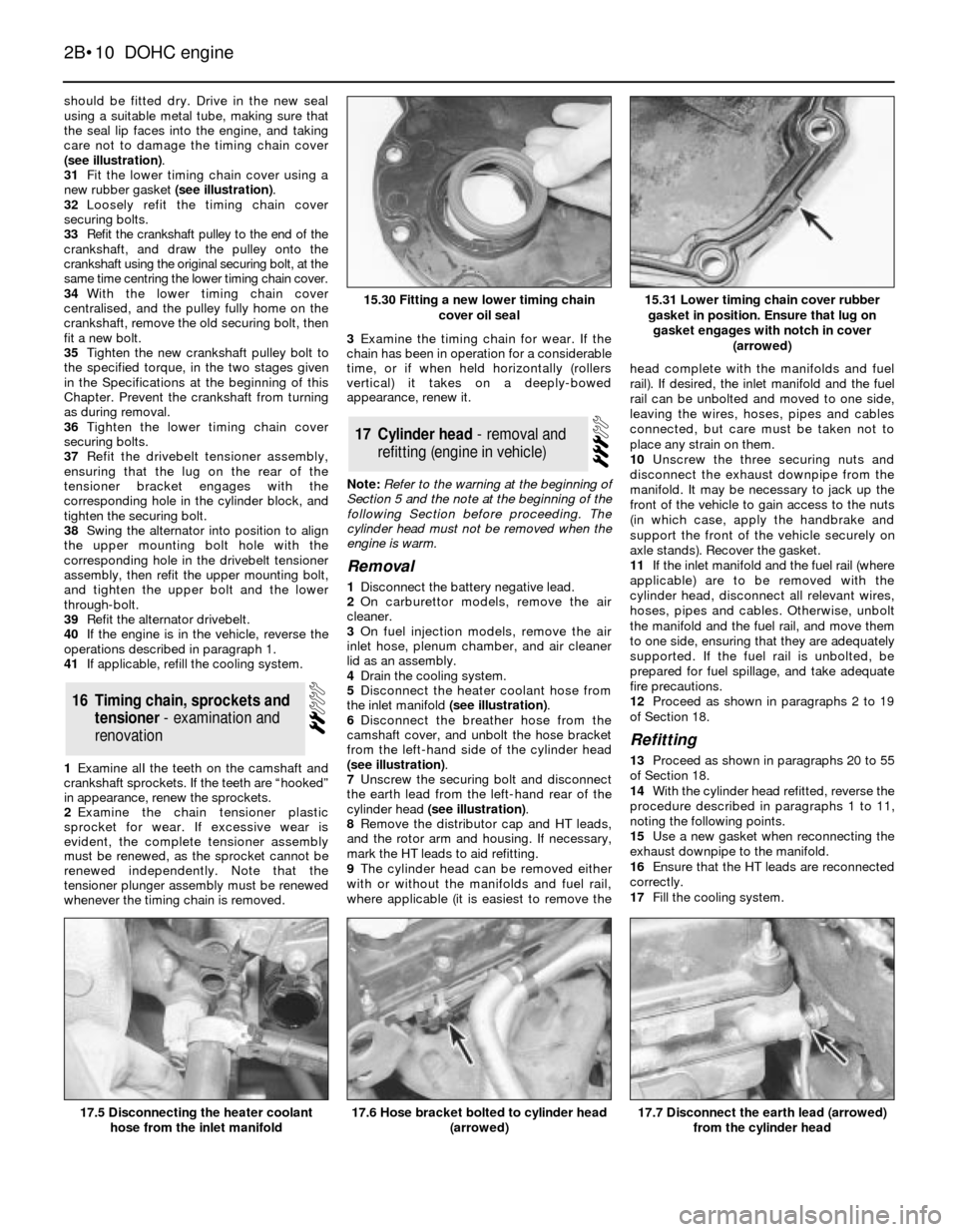
should be fitted dry. Drive in the new seal
using a suitable metal tube, making sure that
the seal lip faces into the engine, and taking
care not to damage the timing chain cover
(see illustration).
31Fit the lower timing chain cover using a
new rubber gasket (see illustration).
32Loosely refit the timing chain cover
securing bolts.
33Refit the crankshaft pulley to the end of the
crankshaft, and draw the pulley onto the
crankshaft using the original securing bolt, at the
same time centring the lower timing chain cover.
34With the lower timing chain cover
centralised, and the pulley fully home on the
crankshaft, remove the old securing bolt, then
fit a new bolt.
35Tighten the new crankshaft pulley bolt to
the specified torque, in the two stages given
in the Specifications at the beginning of this
Chapter. Prevent the crankshaft from turning
as during removal.
36Tighten the lower timing chain cover
securing bolts.
37Refit the drivebelt tensioner assembly,
ensuring that the lug on the rear of the
tensioner bracket engages with the
corresponding hole in the cylinder block, and
tighten the securing bolt.
38Swing the alternator into position to align
the upper mounting bolt hole with the
corresponding hole in the drivebelt tensioner
assembly, then refit the upper mounting bolt,
and tighten the upper bolt and the lower
through-bolt.
39Refit the alternator drivebelt.
40If the engine is in the vehicle, reverse the
operations described in paragraph 1.
41If applicable, refill the cooling system.
1Examine alI the teeth on the camshaft and
crankshaft sprockets. If the teeth are “hooked”
in appearance, renew the sprockets.
2Examine the chain tensioner plastic
sprocket for wear. If excessive wear is
evident, the complete tensioner assembly
must be renewed, as the sprocket cannot be
renewed independently. Note that the
tensioner plunger assembly must be renewed
whenever the timing chain is removed.3Examine the timing chain for wear. If the
chain has been in operation for a considerable
time, or if when held horizontally (rollers
vertical) it takes on a deeply-bowed
appearance, renew it.
Note: Refer to the warning at the beginning of
Section 5 and the note at the beginning of the
following Section before proceeding. The
cylinder head must not be removed when the
engine is warm.
Removal
1Disconnect the battery negative lead.
2On carburettor models, remove the air
cleaner.
3On fuel injection models, remove the air
inlet hose, plenum chamber, and air cleaner
lid as an assembly.
4Drain the cooling system.
5Disconnect the heater coolant hose from
the inlet manifold (see illustration).
6Disconnect the breather hose from the
camshaft cover, and unbolt the hose bracket
from the left-hand side of the cylinder head
(see illustration).
7Unscrew the securing bolt and disconnect
the earth lead from the left-hand rear of the
cylinder head (see illustration).
8Remove the distributor cap and HT leads,
and the rotor arm and housing. If necessary,
mark the HT leads to aid refitting.
9The cylinder head can be removed either
with or without the manifolds and fuel rail,
where applicable (it is easiest to remove thehead complete with the manifolds and fuel
rail). If desired, the inlet manifold and the fuel
rail can be unbolted and moved to one side,
leaving the wires, hoses, pipes and cables
connected, but care must be taken not to
place any strain on them.
10Unscrew the three securing nuts and
disconnect the exhaust downpipe from the
manifold. It may be necessary to jack up the
front of the vehicle to gain access to the nuts
(in which case, apply the handbrake and
support the front of the vehicle securely on
axle stands). Recover the gasket.
11If the inlet manifold and the fuel rail (where
applicable) are to be removed with the
cylinder head, disconnect all relevant wires,
hoses, pipes and cables. Otherwise, unbolt
the manifold and the fuel rail, and move them
to one side, ensuring that they are adequately
supported. If the fuel rail is unbolted, be
prepared for fuel spillage, and take adequate
fire precautions.
12Proceed as shown in paragraphs 2 to 19
of Section 18.
Refitting
13Proceed as shown in paragraphs 20 to 55
of Section 18.
14With the cylinder head refitted, reverse the
procedure described in paragraphs 1 to 11,
noting the following points.
15Use a new gasket when reconnecting the
exhaust downpipe to the manifold.
16Ensure that the HT leads are reconnected
correctly.
17Fill the cooling system.
17Cylinder head - removal and
refitting (engine in vehicle)
16Timing chain, sprockets and
tensioner - examination and
renovation
2B•10DOHC engine
15.30 Fitting a new lower timing chain
cover oil seal
17.5 Disconnecting the heater coolant
hose from the inlet manifold17.7 Disconnect the earth lead (arrowed)
from the cylinder head17.6 Hose bracket bolted to cylinder head
(arrowed)
15.31 Lower timing chain cover rubber
gasket in position. Ensure that lug on
gasket engages with notch in cover
(arrowed)
Page 11 of 18
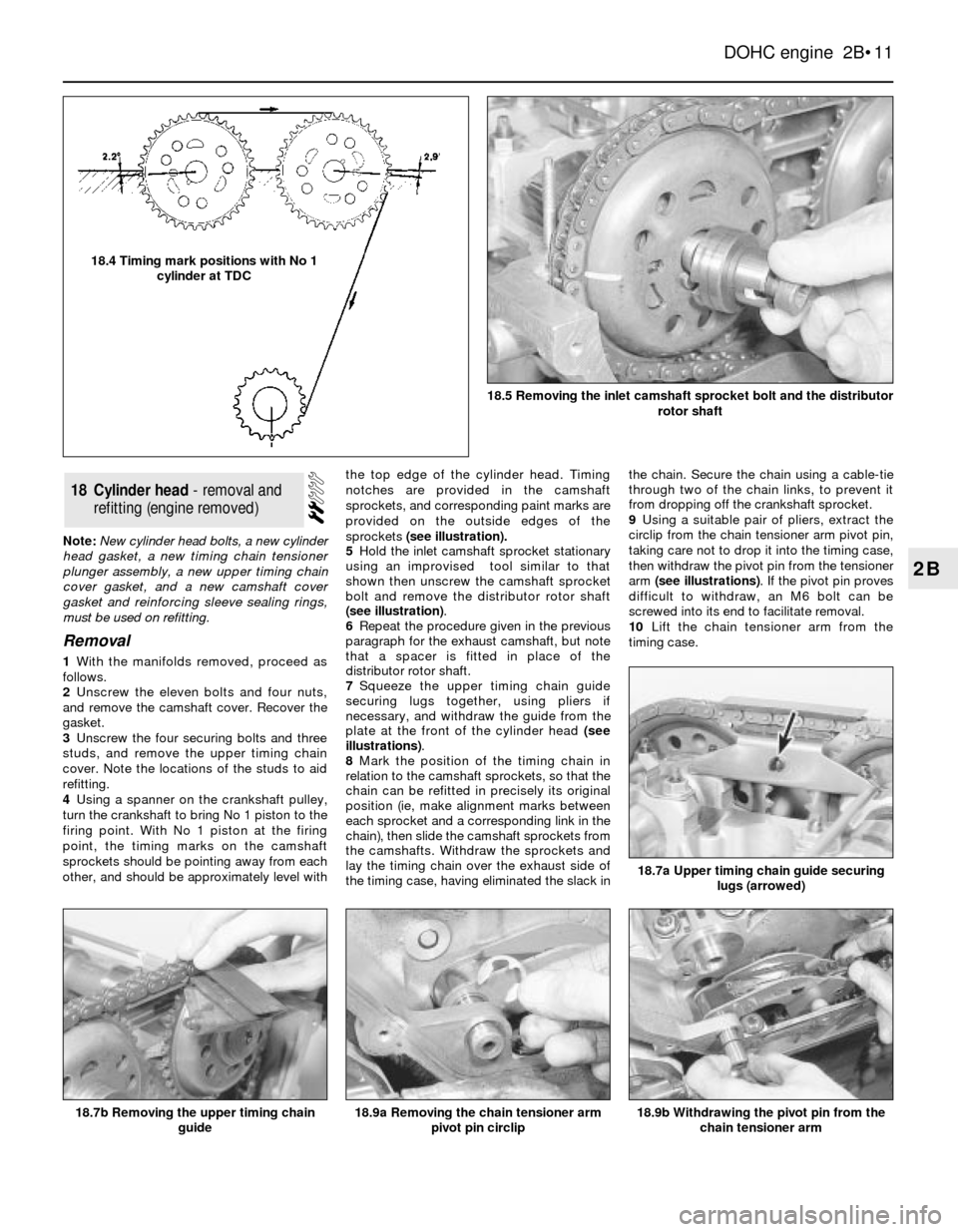
Note: New cylinder head bolts, a new cylinder
head gasket, a new timing chain tensioner
plunger assembly, a new upper timing chain
cover gasket, and a new camshaft cover
gasket and reinforcing sleeve sealing rings,
must be used on refitting.
Removal
1With the manifolds removed, proceed as
follows.
2Unscrew the eleven bolts and four nuts,
and remove the camshaft cover. Recover the
gasket.
3Unscrew the four securing bolts and three
studs, and remove the upper timing chain
cover. Note the locations of the studs to aid
refitting.
4Using a spanner on the crankshaft pulley,
turn the crankshaft to bring No 1 piston to the
firing point. With No 1 piston at the firing
point, the timing marks on the camshaft
sprockets should be pointing away from each
other, and should be approximately level withthe top edge of the cylinder head. Timing
notches are provided in the camshaft
sprockets, and corresponding paint marks are
provided on the outside edges of the
sprockets (see illustration).
5Hold the inlet camshaft sprocket stationary
using an improvised tool similar to that
shownthen unscrew the camshaft sprocket
bolt and remove the distributor rotor shaft
(see illustration).
6Repeat the procedure given in the previous
paragraph for the exhaust camshaft, but note
that a spacer is fitted in place of the
distributor rotor shaft.
7Squeeze the upper timing chain guide
securing lugs together, using pliers if
necessary, and withdraw the guide from the
plate at the front of the cylinder head (see
illustrations).
8Mark the position of the timing chain in
relation to the camshaft sprockets, so that the
chain can be refitted in precisely its original
position (ie, make alignment marks between
each sprocket and a corresponding link in the
chain), then slide the camshaft sprockets from
the camshafts. Withdraw the sprockets and
lay the timing chain over the exhaust side of
the timing case, having eliminated the slack inthe chain. Secure the chain using a cable-tie
through two of the chain links, to prevent it
from dropping off the crankshaft sprocket.
9Using a suitable pair of pliers, extract the
circlip from the chain tensioner arm pivot pin,
taking care not to drop it into the timing case,
then withdraw the pivot pin from the tensioner
arm (see illustrations). If the pivot pin proves
difficult to withdraw, an M6 bolt can be
screwed into its end to facilitate removal.
10Lift the chain tensioner arm from the
timing case.
18Cylinder head - removal and
refitting (engine removed)
DOHC engine 2B•11
2B
18.7a Upper timing chain guide securing
lugs (arrowed)
18.9b Withdrawing the pivot pin from the
chain tensioner arm18.9a Removing the chain tensioner arm
pivot pin circlip18.7b Removing the upper timing chain
guide
18.5 Removing the inlet camshaft sprocket bolt and the distributor
rotor shaft
18.4 Timing mark positions with No 1
cylinder at TDC
Page 12 of 18
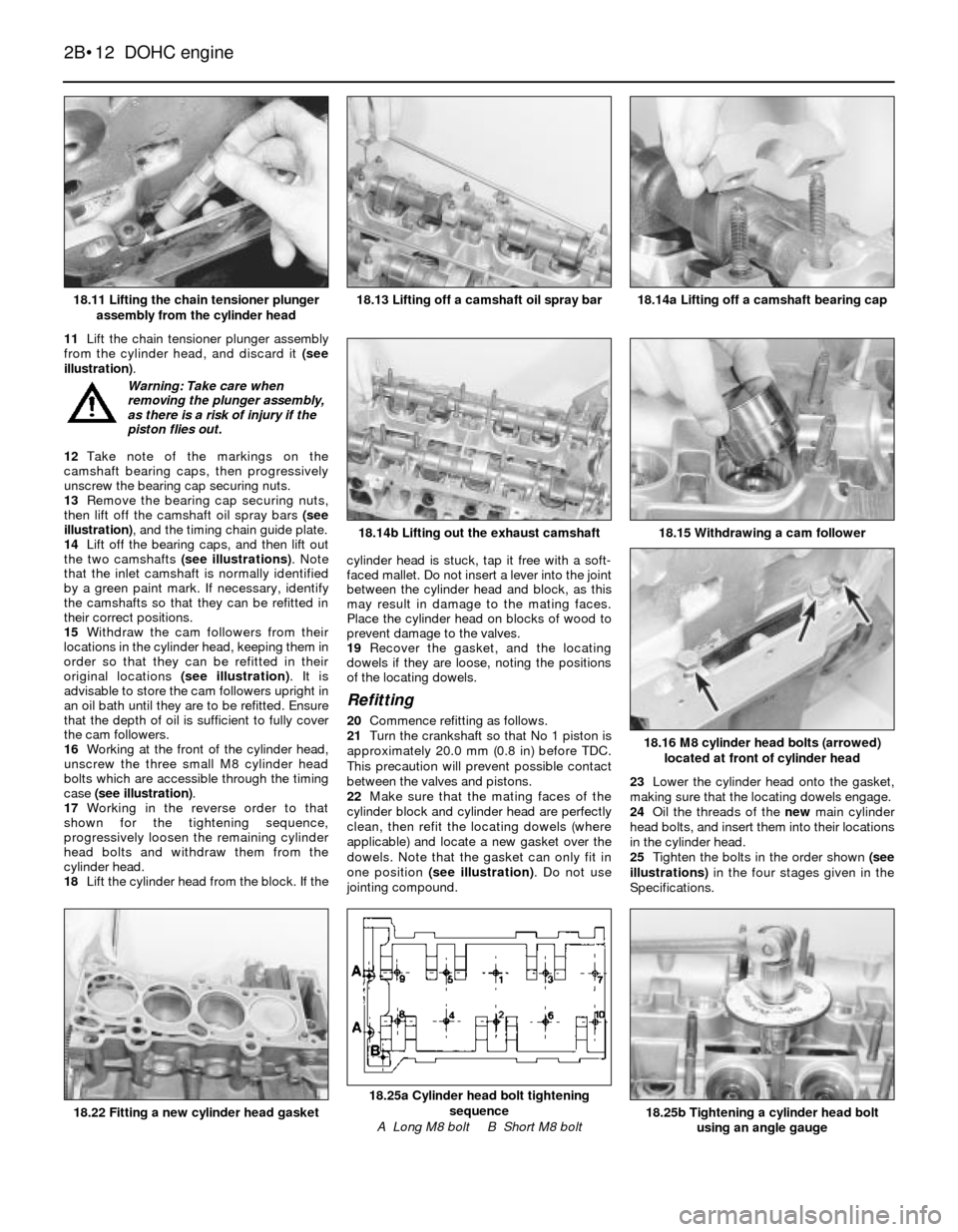
11Lift the chain tensioner plunger assembly
from the cylinder head, and discard it (see
illustration).
12Take note of the markings on the
camshaft bearing caps, then progressively
unscrew the bearing cap securing nuts.
13Remove the bearing cap securing nuts,
then lift off the camshaft oil spray bars (see
illustration), and the timing chain guide plate.
14Lift off the bearing caps, and then lift out
the two camshafts (see illustrations). Note
that the inlet camshaft is normally identified
by a green paint mark. If necessary, identify
the camshafts so that they can be refitted in
their correct positions.
15Withdraw the cam followers from their
locations in the cylinder head, keeping them in
order so that they can be refitted in their
original locations (see illustration). It is
advisable to store the cam followers upright in
an oil bath until they are to be refitted. Ensure
that the depth of oil is sufficient to fully cover
the cam followers.
16Working at the front of the cylinder head,
unscrew the three small M8 cylinder head
bolts which are accessible through the timing
case (see illustration).
17Working in the reverse order to that
shown for the tightening sequence,
progressively loosen the remaining cylinder
head bolts and withdraw them from the
cylinder head.
18Lift the cylinder head from the block. If thecylinder head is stuck, tap it free with a soft-
faced mallet. Do not insert a lever into the joint
between the cylinder head and block, as this
may result in damage to the mating faces.
Place the cylinder head on blocks of wood to
prevent damage to the valves.
19Recover the gasket, and the locating
dowels if they are loose, noting the positions
of the locating dowels.
Refitting
20Commence refitting as follows.
21Turn the crankshaft so that No 1 piston is
approximately 20.0 mm (0.8 in) before TDC.
This precaution will prevent possible contact
between the valves and pistons.
22Make sure that the mating faces of the
cylinder block and cylinder head are perfectly
clean, then refit the locating dowels (where
applicable) and locate a new gasket over the
dowels. Note that the gasket can only fit in
one position (see illustration). Do not use
jointing compound.23Lower the cylinder head onto the gasket,
making sure that the locating dowels engage.
24Oil the threads of the new main cylinder
head bolts, and insert them into their locations
in the cylinder head.
25Tighten the bolts in the order shown (see
illustrations)in the four stages given in the
Specifications.
2B•12DOHC engine
18.11 Lifting the chain tensioner plunger
assembly from the cylinder head18.14a Lifting off a camshaft bearing cap
18.25b Tightening a cylinder head bolt
using an angle gauge
18.25a Cylinder head bolt tightening
sequence
A Long M8 bolt B Short M8 bolt18.22 Fitting a new cylinder head gasket
18.16 M8 cylinder head bolts (arrowed)
located at front of cylinder head
18.15 Withdrawing a cam follower18.14b Lifting out the exhaust camshaft
18.13 Lifting off a camshaft oil spray bar
Warning: Take care when
removing the plunger assembly,
as there is a risk of injury if the
piston flies out.
Page 13 of 18
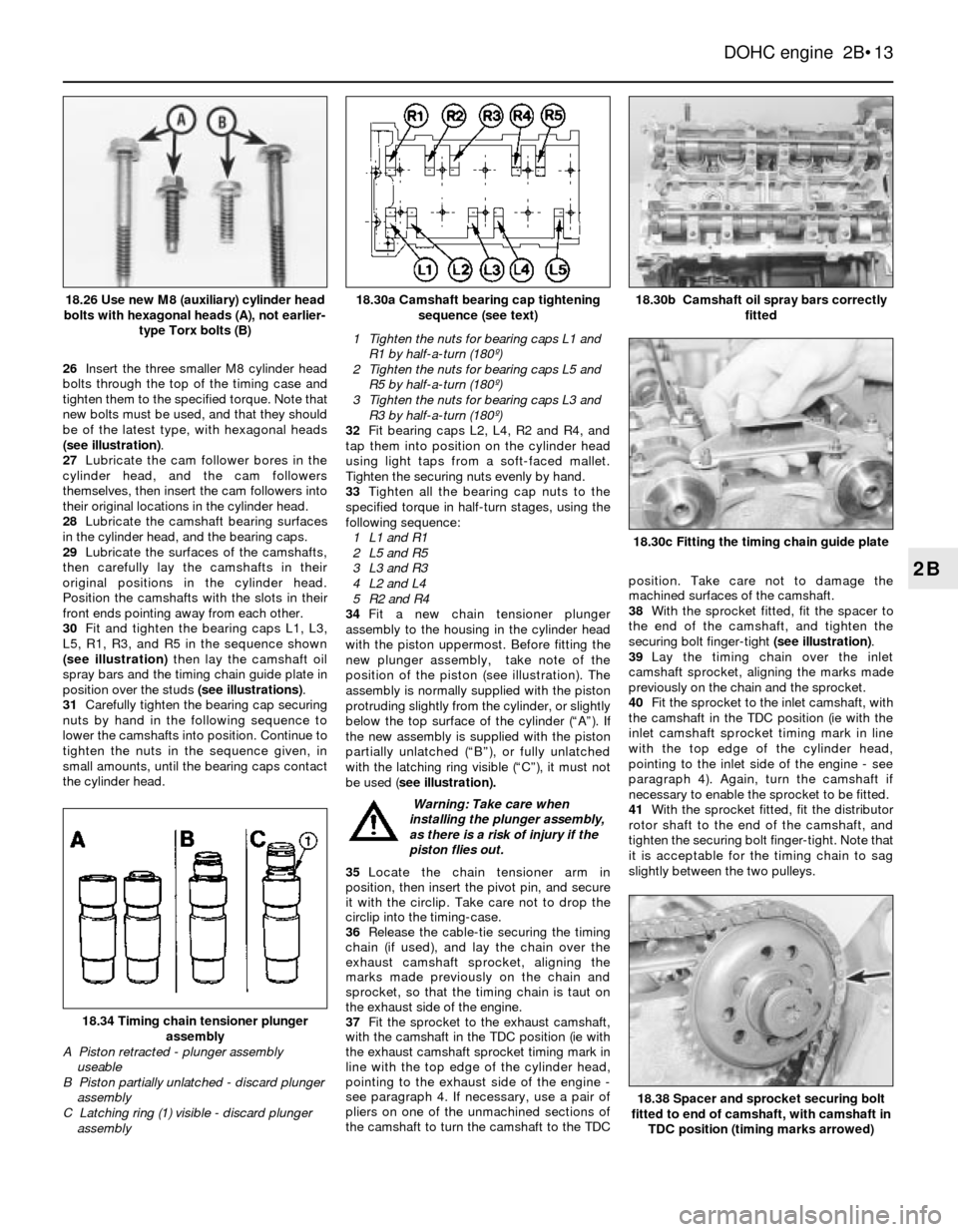
26Insert the three smaller M8 cylinder head
bolts through the top of the timing case and
tighten them to the specified torque. Note that
new bolts must be used, and that they should
be of the latest type, with hexagonal heads
(see illustration).
27Lubricate the cam follower bores in the
cylinder head, and the cam followers
themselves, then insert the cam followers into
their original locations in the cylinder head.
28Lubricate the camshaft bearing surfaces
in the cylinder head, and the bearing caps.
29Lubricate the surfaces of the camshafts,
then carefully lay the camshafts in their
original positions in the cylinder head.
Position the camshafts with the slots in their
front ends pointing away from each other.
30Fit and tighten the bearing caps L1, L3,
L5, R1, R3, and R5 in the sequence shown
(see illustration)then lay the camshaft oil
spray bars and the timing chain guide plate in
position over the studs (see illustrations).
31Carefully tighten the bearing cap securing
nuts by hand in the following sequence to
lower the camshafts into position. Continue to
tighten the nuts in the sequence given, in
small amounts, until the bearing caps contact
the cylinder head.1Tighten the nuts for bearing caps L1 and
R1 by half-a-turn (180º)
2Tighten the nuts for bearing caps L5 and
R5 by half-a-turn (180º)
3Tighten the nuts for bearing caps L3 and
R3 by half-a-turn (180º)
32Fit bearing caps L2, L4, R2 and R4, and
tap them into position on the cylinder head
using light taps from a soft-faced mallet.
Tighten the securing nuts evenly by hand.
33Tighten all the bearing cap nuts to the
specified torque in half-turn stages, using the
following sequence:
1L1 and R1
2L5 and R5
3L3 and R3
4L2 and L4
5R2 and R4
34Fit a newchain tensioner plunger
assembly to the housing in the cylinder head
with the piston uppermost. Before fitting the
new plunger assembly, take note of the
position of the piston(see illustration). The
assembly is normally supplied with the piston
protruding slightly from the cylinder, or slightly
below the top surface of the cylinder (“A”). If
the new assembly is supplied with the piston
partially unlatched (“B”), or fully unlatched
with the latching ring visible (“C”), it must not
be used (see illustration).
35Locate the chain tensioner arm in
position, then insert the pivot pin, and secure
it with the circlip. Take care not to drop the
circlip into the timing-case.
36Release the cable-tie securing the timing
chain (if used), and lay the chain over the
exhaust camshaft sprocket, aligning the
marks made previously on the chain and
sprocket, so that the timing chain is taut on
the exhaust side of the engine.
37Fit the sprocket to the exhaust camshaft,
with the camshaft in the TDC position (ie with
the exhaust camshaft sprocket timing mark in
line with the top edge of the cylinder head,
pointing to the exhaust side of the engine -
see paragraph 4. If necessary, use a pair of
pliers on one of the unmachined sections of
the camshaft to turn the camshaft to the TDCposition. Take care not to damage the
machined surfaces of the camshaft.
38With the sprocket fitted, fit the spacer to
the end of the camshaft, and tighten the
securing bolt finger-tight (see illustration).
39Lay the timing chain over the inlet
camshaft sprocket, aligning the marks made
previously on the chain and the sprocket.
40Fit the sprocket to the inlet camshaft, with
the camshaft in the TDC position (ie with the
inlet camshaft sprocket timing mark in line
with the top edge of the cylinder head,
pointing to the inlet side of the engine - see
paragraph 4). Again, turn the camshaft if
necessary to enable the sprocket to be fitted.
41With the sprocket fitted, fit the distributor
rotor shaft to the end of the camshaft, and
tighten the securing bolt finger-tight. Note that
it is acceptable for the timing chain to sag
slightly between the two pulleys.
DOHC engine 2B•13
2B
18.30b Camshaft oil spray bars correctly
fitted
18.38 Spacer and sprocket securing bolt
fitted to end of camshaft, with camshaft in
TDC position (timing marks arrowed)
18.34 Timing chain tensioner plunger
assembly
A Piston retracted - plunger assembly
useable
B Piston partially unlatched - discard plunger
assembly
C Latching ring (1) visible - discard plunger
assembly
18.30c Fitting the timing chain guide plate
18.30a Camshaft bearing cap tightening
sequence (see text)18.26 Use new M8 (auxiliary) cylinder head
bolts with hexagonal heads (A), not earlier-
type Torx bolts (B)
Warning: Take care when
installing the plunger assembly,
as there is a risk of injury if the
piston flies out.
Page 14 of 18
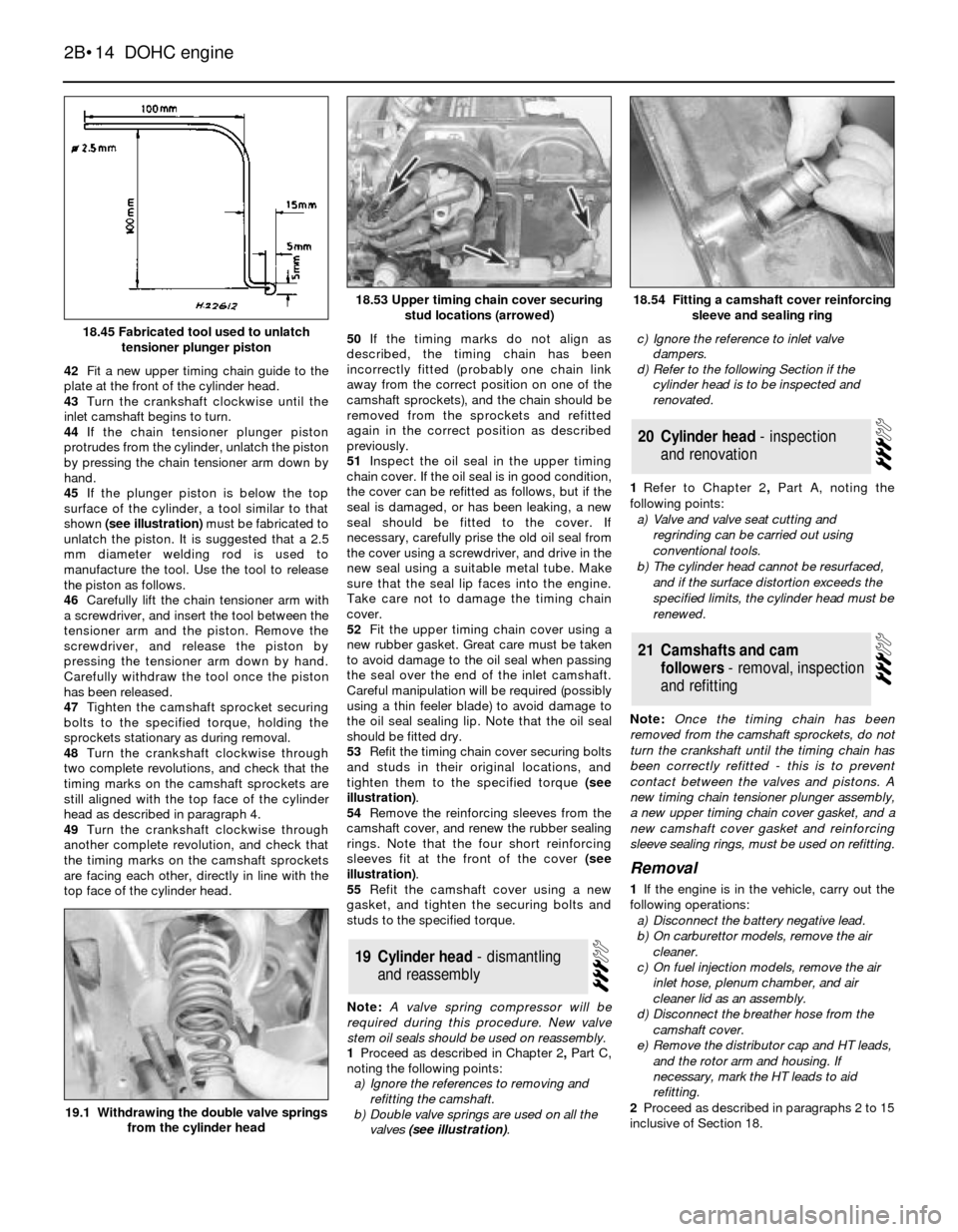
42Fit a new upper timing chain guide to the
plate at the front of the cylinder head.
43Turn the crankshaft clockwise until the
inlet camshaft begins to turn.
44If the chain tensioner plunger piston
protrudes from the cylinder, unlatch the piston
by pressing the chain tensioner arm down by
hand.
45If the plunger piston is below the top
surface of the cylinder, a tool similar to that
shown(see illustration)must be fabricated to
unlatch the piston. It is suggested that a 2.5
mm diameter welding rod is used to
manufacture the tool. Use the tool to release
the piston as follows.
46Carefully lift the chain tensioner arm with
a screwdriver, and insert the tool between the
tensioner arm and the piston. Remove the
screwdriver, and release the piston by
pressing the tensioner arm down by hand.
Carefully withdraw the tool once the piston
has been released.
47Tighten the camshaft sprocket securing
bolts to the specified torque, holding the
sprockets stationary as during removal.
48Turn the crankshaft clockwise through
two complete revolutions, and check that the
timing marks on the camshaft sprockets are
still aligned with the top face of the cylinder
head as described in paragraph 4.
49Turn the crankshaft clockwise through
another complete revolution, and check that
the timing marks on the camshaft sprockets
are facing each other, directly in line with the
top face of the cylinder head. 50If the timing marks do not align as
described, the timing chain has been
incorrectly fitted (probably one chain link
away from the correct position on one of the
camshaft sprockets), and the chain should be
removed from the sprockets and refitted
again in the correct position as described
previously.
51Inspect the oil seal in the upper timing
chain cover. If the oil seal is in good condition,
the cover can be refitted as follows, but if the
seal is damaged, or has been leaking, a new
seal should be fitted to the cover. If
necessary, carefully prise the old oil seal from
the cover using a screwdriver, and drive in the
new seal using a suitable metal tube. Make
sure that the seal lip faces into the engine.
Take care not to damage the timing chain
cover.
52Fit the upper timing chain cover using a
new rubber gasket. Great care must be taken
to avoid damage to the oil seal when passing
the seal over the end of the inlet camshaft.
Careful manipulation will be required (possibly
using a thin feeler blade) to avoid damage to
the oil seal sealing lip. Note that the oil seal
should be fitted dry.
53Refit the timing chain cover securing bolts
and studs in their original locations, and
tighten them to the specified torque (see
illustration).
54Remove the reinforcing sleeves from the
camshaft cover, and renew the rubber sealing
rings. Note that the four short reinforcing
sleeves fit at the front of the cover (see
illustration).
55Refit the camshaft cover using a new
gasket, and tighten the securing bolts and
studs to the specified torque.
Note: A valve spring compressor will be
required during this procedure. New valve
stem oil seals should be used on reassembly.
1Proceed as described in Chapter 2, PartC,
noting the following points:
a)Ignore the references to removing and
refitting the camshaft.
b)Double valve springs are used on all the
valves (see illustration).c)Ignore the reference to inlet valve
dampers.
d)Refer to the following Section if the
cylinder head is to be inspected and
renovated.
1Refer to Chapter 2, PartA, noting the
following points:
a)Valve and valve seat cutting and
regrinding can be carried out using
conventional tools.
b)The cylinder head cannot be resurfaced,
and if the surface distortion exceeds the
specified limits, the cylinder head must be
renewed.
Note: Once the timing chain has been
removed from the camshaft sprockets, do not
turn the crankshaft until the timing chain has
been correctly refitted - this is to prevent
contact between the valves and pistons. A
new timing chain tensioner plunger assembly,
a new upper timing chain cover gasket, and a
new camshaft cover gasket and reinforcing
sleeve sealing rings, must be used on refitting.
Removal
1If the engine is in the vehicle, carry out the
following operations:
a)Disconnect the battery negative lead.
b)On carburettor models, remove the air
cleaner.
c)On fuel injection models, remove the air
inlet hose, plenum chamber, and air
cleaner lid as an assembly.
d)Disconnect the breather hose from the
camshaft cover.
e)Remove the distributor cap and HT leads,
and the rotor arm and housing. If
necessary, mark the HT leads to aid
refitting.
2Proceed as described in paragraphs 2 to 15
inclusive of Section 18.
21Camshafts and cam
followers - removal, inspection
and refitting
20Cylinder head - inspection
and renovation
19Cylinder head - dismantling
and reassembly
2B•14DOHC engine
18.45 Fabricated tool used to unlatch
tensioner plunger piston
18.54 Fitting a camshaft cover reinforcing
sleeve and sealing ring
19.1 Withdrawing the double valve springs
from the cylinder head
18.53 Upper timing chain cover securing
stud locations (arrowed)